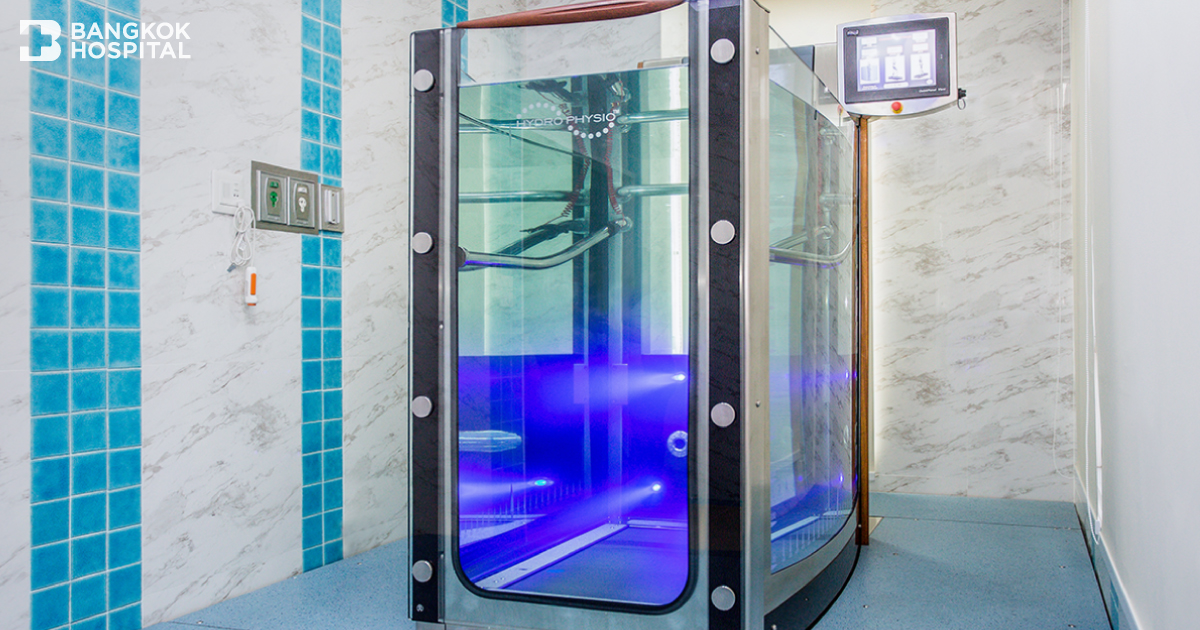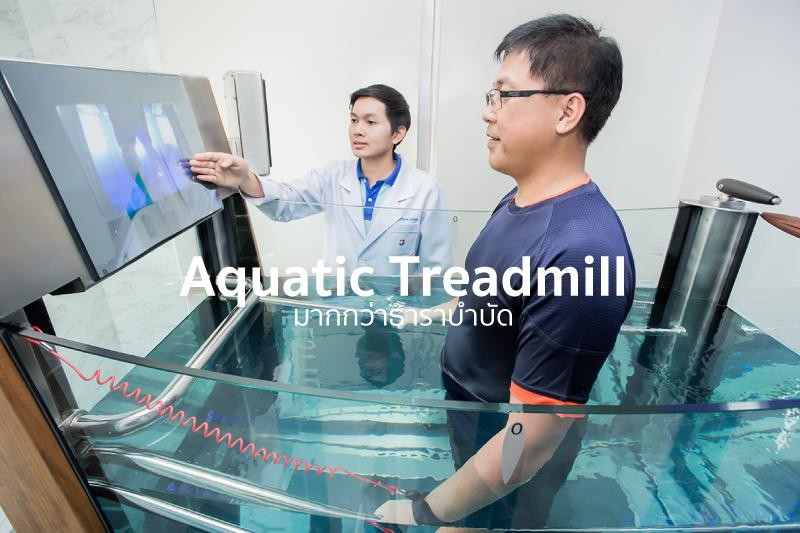Aquatic Treadmill: Promoting Range Of Motion While Improving Gait And Strengthening Muscles
Rehabilitation Center, Bangkok Hospital has launched a revolutionizing aquatic therapy, known as “aquatic treadmill”. Aiming at enhancing rehabilitation and physical performance, aquatic treadmill deploys hydrostatic pressure, buoyancy and resistance in the water. This integrative underwater treadmill equipment delivers distinct advantages in promoting early range of motion, improving gait patterns and strengthening affected muscles while facilitating the healing process. Due to an adjustable hydrostatic pressure and water depth, aquatic treadmill helps patients to improve their range of motion, strength and flexibility based on their individual fitness levels presenting with a wide range of health conditions. In addition, treadmill speed and incline can be individually adjusted, allowing for a personalized program that is best suited for each individual.
Aquatic treadmill in Rehabilitation Center has been installed in private a room, enabling the patients to obtain their privacy while exercising. The treadmill itself is connected with a screen monitoring that displays real-time movement images. All functions are controlled automatically with intuitive touch screen interface. Water depth can be easily changed to progress patients or challenge athletes. Physical exertion under the water enables the rehabilitation specialist to access and evaluate the strength, flexibility and range of motion. As a result, biomechanics of movement, physical performance and gait patterns can be improved appropriately. Moreover, while running on aquatic treadmill, the body undergoes greater exertion due to the viscosity of the water, leading to greater hip, leg and foot strength, as well as improvements in core muscle groups throughout the body. This aquatic treadmill is highly advised in the following groups:
- Patients who require a fast recovery after injuries or surgeries
- Obese people who have limited physical fitness levels
- Athletes or persons who need to improve their physical strength and performance.
How Aquatic Treadmill Works
Aquatic treadmill training is a rehabilitation method of gait training that utilizes the water as a therapeutic medium. Beneficial characteristics of water include:
- Density and buoyancy:
Based on scientific fact, the average density of the human body is less than water density. In combination with buoyancy, it makes the body float on the water. Additionally, water depth helps support body weight. While underwater, the body weight is reduced drastically. Aquatic treadmill deploys water buoyancy and density to run a gait training session with alleviated weight, allowing the patients to move their extremities freely in the water. Compared to the on-ground weight support treadmill, aquatic treadmill significantly reduces physical forces applied to the affected joints, resulting in minimized injuries. Given VDO clip illustrates water characteristics that pose superior advantages over land treadmill workouts. VDO clip XXX - Hydrostatic pressure:
The natural hydrostatic pressure of water facilitates the healing process. Not only does the water reduce leg and arm swelling, but it also relaxes joints, improves strength and boosts flexibility. Given VDO clip illustrates hydrostatic pressure that alleviates swollen leg. VDO clip XXX - Resistance:
Water resistance aids strengthening the core muscles in the body, similar to on-ground weight lifting. Strength training by using aquatic treadmill also enhances physical and cardiovascular endurance which in turn boosts a patient’s on-ground physical stamina. - Thermodynamics:
When combined with the thermodynamic property of water, warm water used for aquatic treadmill stimulates sensory effects and regulates blood circulation, enabling the patients to enjoy more joint and muscle relaxation.
Benefits Of Aquatic Treadmill
- Reducing physical force applied to the joints by using buoyancy in the water.
- Strengthening the muscles and improving physical endurance by using water resistance (Jet Stream) and adjustable speed and incline.
- Relaxing the muscles through temperature adjustment.
- Stimulating blood circulation throughout the body. Increasing muscle and joint flexibility. Minimizing pain and enhancing relaxation.
- Promoting range of motion and improving movement stability.
Who Get Benefits From Aquatic Treadmill
- General persons or athletes who need to improve physical fitness levels and physical performance.
- Elderly people or persons who are at risk of falls and movement instability.
- People who have experienced joint or muscle pain caused by certain diseases, such as arthritis or chronic inflammation, spondylosis or fracture.
- Patients who undergo knee or hip replacement surgery (before and after surgery)
- Obese people who need to improve physical fitness with less chance of injuries
Aquatic Treadmill Is NOT Recommended In People Who Have:
- Inability to control bowel movements
- Urinary tract infections
- Open wounds
- Contagious skin diseases
- Underlying diseases, such as heart disease and epilepsy
- Menstruation during exercise
- Abnormal vital signs, such as body temperature, respiratory rate and blood pressure
Precautions For Aquatic Treadmill
Since the patients have to run on the treadmill under the water by themselves, therefore the patients are required to be able to maintain their balance (fair to good functional balance grade), both static and dynamic. Prior to exercise, the balance will be evaluated by rehabilitation specialist or physiotherapist. However, an exception applies to pediatric patients who are under 12. In such a case, the physiotherapist needs to closely supervise the patients in the aquatic chamber.








